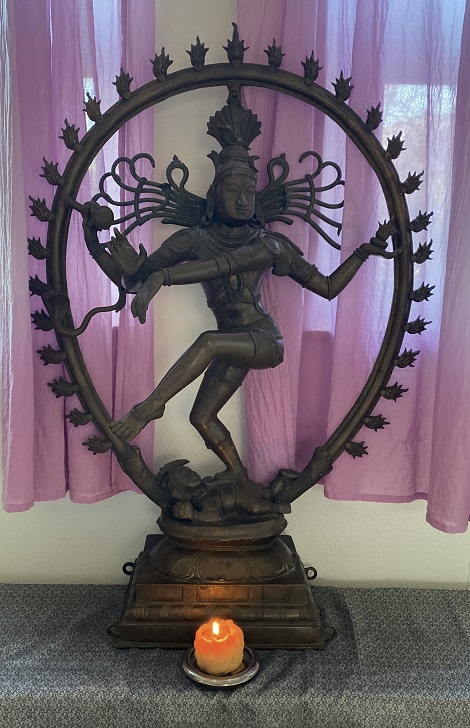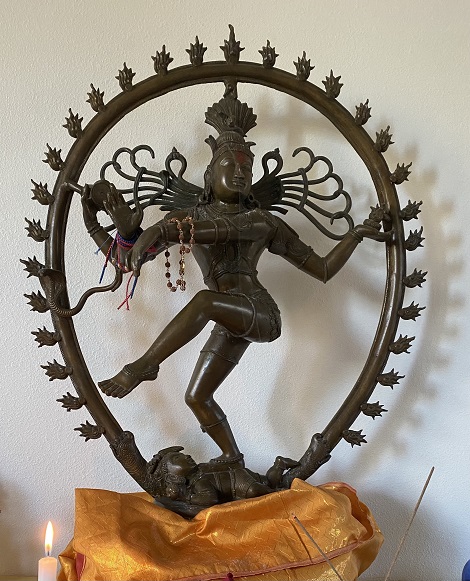One of the most popular images in yoga culture is the figure of four-armed Naṭarāja standing in a ring of fire on one leg, with the other foot upturned. From a Tantric perspective, Śiva is the ground of being from which all of the manifest world arises. In the image of Naṭarāja, Śiva the Absolute is dancing the manifest world into existence.
Encoded into the image of Naṭarāja are the pañca-kṛtyas, the five acts of Śiva. Pañca means “five.” Kṛtya comes from the verbal root kṛ meaning “to make or do.” So these are the five acts of the Highest. The pañca-kṛtyas can be thought of as different attributes of Śiva’s dance. The pañca-kṛtyas/five acts are sṛṣṭi/creation, sthiti/maintenance, saṃhāra/dissolution, tirodhāna, vilaya, or nigraha/concealment, and anugraha/revelation or grace.
Remember that Śiva is the Highest unmanifest ultimate reality, the ground of being, existing beyond time and space. Because of that, the description of Naṭarāja will at times be paradoxical, and one paradox is that Śiva performs all these actions simultaneously and continuously. As he dances, he is simultaneously creating, sustaining, dissolving, concealing, and revealing.
There are layers of meaning here and one way to look at these five acts is to consider the triad of creation, maintenance, and dissolution, along with the dyad of concealment and revelation. Here we’ll first examine the triad of creation, maintenance, and dissolution in more detail.
The image of Naṭarāja encodes various attributes of Śiva-Śakti as both the ground of being and that from which all the manifest world emerges. There are different interpretations of this mapping of the pañca-kṛtyas onto the Śiva Naṭarāja, which I will point out as we go. See what resonates most for you. It is important to note that I will be indicating right and left, and that refers to Naṭarāja’s right or left, which will be opposite to you as you look at it.
Starting with Śiva Naṭarāja’s top right hand, which is on our left as we look at it, Naṭarāja holds a drum called the damaru. The drum is cinched in its middle by a string with something like a pebble at the end that strikes the drumhead. As the drum is flicked back and forth, the pebble creates a “tick-tock” rhythm, like the pulse of creation giving rise to all of manifestation. This is the first act of Śiva: sṛṣṭi/creation. The drum represents the action of creating, of manifesting, it is the pulse, the beat of life. The dance of life begins; the heart starts beating. The drum is a rhythm, the creative pulse from which everything flows into existence. The unmanifest ground of reality starts vibrating everything into manifestation.
The second of the pañca-kṛtyas is sthiti: sustenance, persistence, or maintenance. In one mapping it is represented by the upturned right hand in abhaya–mudrā, that gesture of fearlessness. Another mapping teaches that sthiti/persistence is represented by the supporting leg. That steady leg supports the entire dance and therefore relates to that steadfast and persevering energy of sthiti. The sturdy leg seems to be holding everything together. It is the balancing act of life. Whatever is manifested must then be maintained. There is some persistence for a while, until of course there isn’t, since all manifest things eventually dissolve.
Naṭarāja’s topmost left hand (on our right) holds fire, representing saṃhāra, the third of the pañca-kṛtyas. Fire burns and is destructive, so this is symbolic of dissolution, destruction, reabsorption, or transformation. In the larger context of the Hindu gods, Śiva is a very fierce god, known as the destroyer. A related meaning is dissolution or reabsorption, where everything emitted is eventually reabsorbed back into the Divine.
Sṛṣṭi/creation comes from the verbal root sṛj, which means “to emit, to pour forth, to let go.” Śiva as the unmanifest pure Consciousness holds everything in potential form (as in the liṅga). Sṛṣṭi is the agency within the Absolute that unfolds what has been held in potential form. It can be thought of as the unfolding of that which is already present in potential form. Sṛṣṭi can be a sense of just letting go and emitting, which infers that creation is not necessarily hard work and is, perhaps, even a sense of play. The Divine allows the manifest to flow out.
And then sthiti/sustenance, the second part of this triad, is what maintains that which has been created. If there wasn’t some maintaining quality, whatever was created would be instantaneously gone. So sthiti is the energy that maintains things for some period of time.
Then everything manifest eventually dissolves. This is saṃhāra/dissolution. Destruction is one way to think of saṃhāra, but it is also withdrawal, dissolution, or even transformation. What has been manifested and sustained for some time is now reabsorbed or retracted back into the Absolute. Saṃhāra as transformation means something old has to dissolve and be turned into something else. It is represented by the fire that Naṭarāja holds, and where I live in the western United States, fire can be extremely destructive. However, when the forests burn, space is created for new growth to unfold.
These acts/kṛtyas take place on all scales, from the macrocosmic scale of the whole universe to the microcosm of individual awareness—and everything in between. So these three unfold on all levels of reality. Everything pulses into existence, persists for some time, then dissolves. It occurs in the cycle of day and night, the seasons of the year, and in our own breath. Hindu philosophy talks of even greater cycles or ages, called yugas. These acts are embodied in our human life: we’re born, we live, we die. I’m fond of the idea that at birth, the Divine exhales us out, and we take in our first breath. The divine act of emitting or unfolding us is sṛṣṭi, manifestation. Then at death, we exhale our last breath, and the Divine breathes us back in. This is saṃhāra, dissolution, the sense that our individual self dissolves and is reabsorbed into the Divine.
In our individual lives, this triad operates in every action we take. Sṛṣṭi is the creative impulse flowing forth, our self-expression through action. Sthiti is maintaining that action, and saṃhāra is allowing it to end. These three can also be considered at the level of thoughts, how they arise, catch our attention for some time, then fall away. It can be illuminative to explore how and what we create, maintain, and dissolve in our lives, and how that helps us to live our yoga.
Reflect and Explore
List and define these first three of the pañca-kṛtyas/five acts. Contemplate their meanings, and give examples from your life.
How do the different mappings of Naṭarāja inform your understanding?
Observe the cycle of creation, maintenance, and dissolution in some different aspects of your experience and life.





